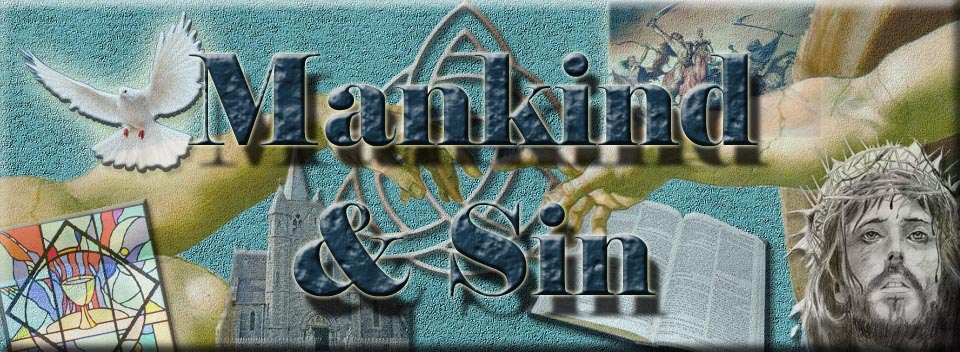
The Doctrine of Man
by Charles C. Ryrie
Ryrie Study Bible
| I. The Origin of Man A. Types of Evolutionary Theories. 1. Atheistic evolution sees spontaneous generation as the original cause. 2. Theistic evolution sees a Divine Power as the original cause and guiding force. Both may include accidental variation, natural selection, and inheritability of acquired characteristics. B. Creationism. 1. The evidence of biblical revelation. a. Extent of evidence. Although the Bible is not a textbook of science, whenever it relates a scientific fact it records it without error. b. Authority of evidence. Whatever is said as truth is authoritative. 2. The facts in the evidence. a. Bara’ is used in Genesis 1:1, 21, 27. b. The word day is used of what we now calibrate in twenty-four hours, and it is used also of a longer period of time. c. Creation is regarded as historical fact in many places in Scripture (Ex. 20; Ps. 8; Matt. 19; Heb. 4). d. The beginning of the first day is at Gen. 1:3. A long period of time may be involved in verse 2. e. The geological ages may be due to a catastrophe (related or not to the fall of Satan) after the original creation, or they may have been caused by the Flood. II. The Material Part of Man (Body) A. Its Creation (Gen. 2:7; 3:19). B. Its Designations. 1. Body (Matt. 6:22). 2. Flesh (Gal. 2:20, where it is a synonym for body). Flesh sometimes stands for the whole person (1 Peter 1:24) and sometimes for the sin nature (Rom. 7:18). 3. Body of humiliation (Phil. 3:21). 4. Earthen vessel (2 Cor. 4:7). 5. Temple of the Holy Spirit (1 Cor. 6:19). C. Its Future. All men will be raised from the dead (John 5:28-29). The unredeemed will be resurrected to eternal existence in the lake of fire (Rev. 20:12, 15) and the redeemed to heaven. III. The Immaterial Part of Man (Soul and Spirit) A. Its Origin (Gen. 2:7). B. Its Characteristic—"image and likeness of God.’’ Adam’s original state was one of unconfirmed creaturely holiness. He lost this by the Fall, but man still retains vestiges of God’s image and likeness (1 Cor. 11:7; James 3:9). C. The Transmission of the Immaterial Part of Man. 1. Preexistent theory. The souls of all men were created at the beginning and are confined in physical bodies. 2. Creationism. The soul of man is created by God when the body is born. 3. Traducianism. The soul is transmitted by natural generation just as the body is. D. The Facets of the Immaterial Part of Man. 1. Soul. Soul stands for the personal life or for the individual. It has emotion (Jer. 31:25) and wars against the lusts of the flesh (1 Peter 2:11). 2. Spirit. Spirit is related to higher aspects of man (Rom. 8:16). All men have a spirit (1 Cor. 2:11). It may also be corrupted (2 Cor. 7:1). Although there is distinction between soul and spirit, they both are facets of the immaterial nature of man. 3. Heart. Heart is the largest concept of all the facets of man’s immaterial nature. It is the seat of intellectual, emotional, volitional, and spiritual life of man (Heb. 4:12; Matt. 22:37; Heb. 4:7). 4. Conscience. Conscience is a witness within that has been affected by the Fall but which nevertheless can be a safe guide at times (1 Peter 2:19; Heb. 10:22). 5. Mind. The mind is the facet of man’s immaterial nature in which understanding is centered. The mind was affected by the Fall but is able to be renewed in Christ (Rom. 12:2). 6. Flesh. When flesh means the sin nature, then this too is an aspect of man’s immaterial nature. It is completely corrupt and cannot be renewed but will be eradicated at death. IV. The Fall of Man A. Attitudes Toward Genesis 3. 1. The liberal view—a legend, a general picture of religion and morals in the light of a later period. 2. The neo-orthodox view—myth, primal history, or "true myth.’’ Barthians consider the account as not being historical but as expressing truths; i.e., truth without fact (if that is possible). B. The Test. The prohibition not to eat of the fruit of the tree of the knowledge of good and evil ultimately was a test of obedience to the revealed will of God. It was certainly not merely a matter of proper diet! C. The Fall. First, Satan attempted to get Eve to doubt the goodness of God because He had held back one tree from them (Gen. 3:1, "every’’). Second, Satan offered Eve his substitute plan, which would allow eating without the penalty (vv. 4-5). Third, Eve prejustified her eating (v. 6). Fourth, Eve ate and Adam followed. D. The Penalties. 1. On the serpent (Gen. 3:14). 2. On Satan (v. 15). a. Enmity between hosts of evil and seed of the woman. b. Satan would be allowed to give Christ a painful but not deadly wound ("heel’’). c. Satan would be given a fatal wound ("head’’). 3. On Eve and women (v. 16). a. Pain in childbirth. b. Submission to husband. 4. On Adam and man (vv. 17-19). a. Cursing of the ground. b. Hard labor. 5. On the race (vv. 20-24). a. Broken fellowship with God. b. Physical death. c. Expulsion from Eden.
|
||
|
||
| Taken from: Ryrie Study Bible NASB © 1986, 1995 by the Moody Bible Institute of Chicago |
-
Site Navigation
 Home
Home What's New
What's New Bible
Bible Photos
Photos Hiking
Hiking E-Books
E-Books Genealogy
Genealogy Profile
Free Plug-ins You May Need
Profile
Free Plug-ins You May Need
 Get Java
Get Java.png) Get Flash
Get Flash Get 7-Zip
Get 7-Zip Get Acrobat Reader
Get Acrobat Reader Get TheWORD
Get TheWORD

